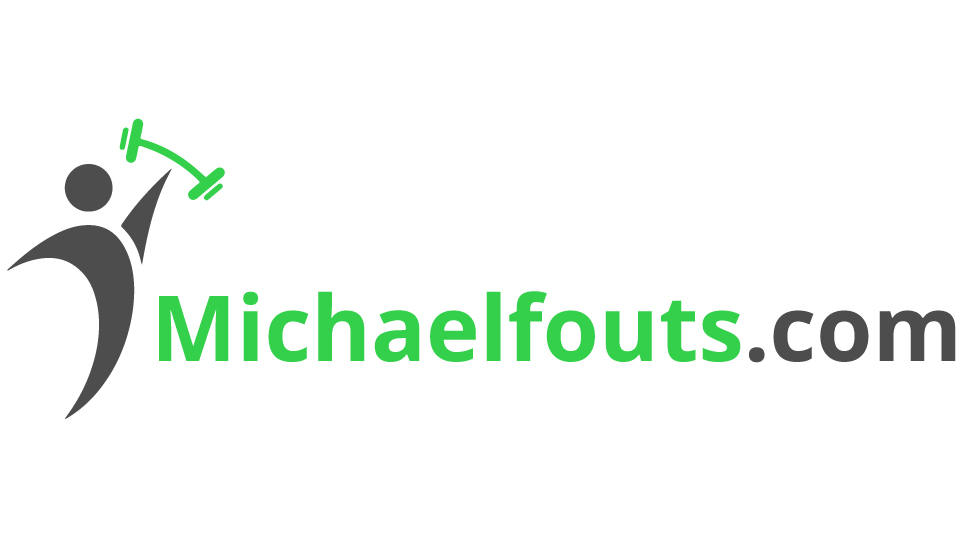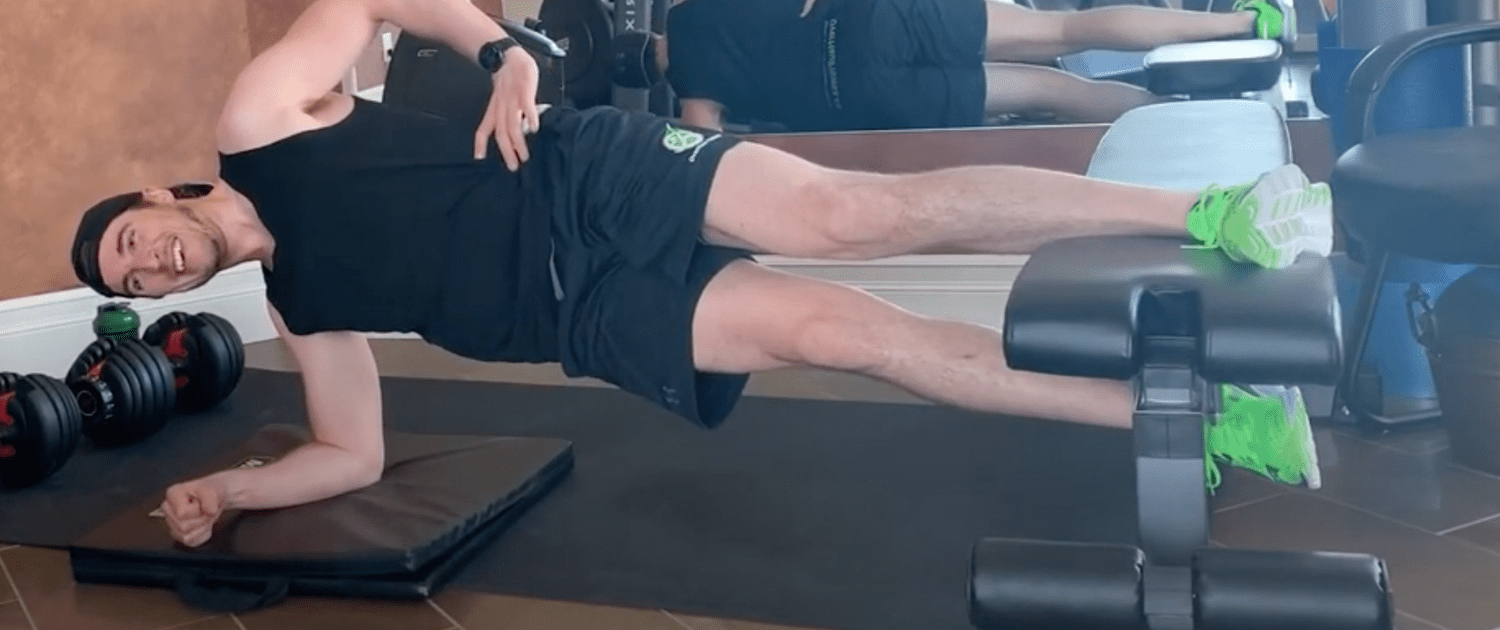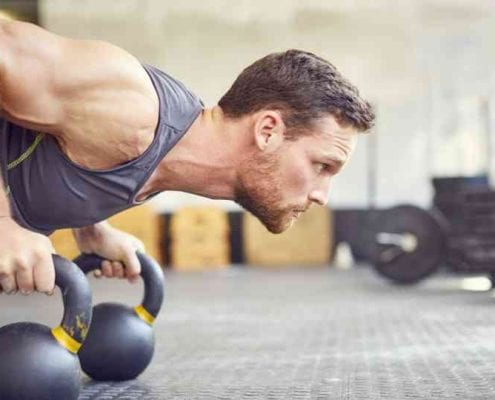3 Home-Gym Equipment Set Ups For Different Fitness Goals
Dec 1, 2020 by Michael Fouts
Big smiles doing a Copenhagen Plank – not always. In other news, I’ve outlined some different home gym Set-Ups you can use and what particular goal they are good for achieving.
Affiliate Disclosure: In this blog I’ve linked pieces of equipment I’m familiar with and recommend, with exception for the “Pieces of Equipment I’d Skip” section where the links are more there for a visual reference. These links, most of them at least, are affiliate links. This means that if you click through a link and make a decision to purchase, OverHaul Fitness Inc. will receive some compensation from the vendor – at no cost to you.
Without further ado…
Set-Up #1: Suspension Trainer, Workout Mat
This set-up is best for:
- If you have limited space.
- Good place to start If you are fairly new to fitness.
- Cost-effective fitness option.
- Good for multiple fitness goals: fat loss, building muscle, strength training, and stability training.
- If you need a travel-friendly fitness option.
A suspension trainer is a piece of equipment that uses two nylon straps with handles attached to a vertical anchor point. With these two straps you can do a wide variety of exercises, effectively targeting all muscle groups. All you need is a door (the door attachment goes over the top of the door, with a closed door it braces against the door frame and door), or a vertical attachment point (like an I beam, or one of the anchors you can install that come with it).
Equipment suggestions: TRX Suspension Trainer, Workout Mat
Why?
If you have limited space, or are fairly new to fitness this is a great place to start. That isn’t to say you can’t get in a good workout if you’re not new to fitness, you definitely can. What’s handy about having a suspension trainer, like a TRX, is that it’s a travel-friendly fitness option. It packs well and you can bring it wherever you go.
Set-Up #2: Dumbbells, Workout Bench
This set-up is best for:
- If you have limited space.
- Good place to start for beginner to Intermediate fitness levels.
- Good for multiple fitness goals: fat loss, building muscle, strength training, and stability.
Selectable type dumbbells (one central dumbbell where you have multiple weight options) are often the best option here, for space and money (FYI currently, during these COVID times, the price of selectables are inflated 200-300%). If selectables aren’t an option for you, look to get at least 1 heavier dumbbell (think hard to do 12 reps of Flat Dumbbell Chest Press), 1 Intermediate weight dumbbell (think hard to do 12 reps of Seated Dumbbell Shoulder Press), and 1 lighter set (think hard to do 12 reps of Lateral Dumbbell Raises). As for a workout bench, most will do, but if you get an adjustable bench it will increase the amount of exercises you can do; – this can be important for adding variety to your workouts.
Equipment suggestions: 1 set Bowflex Selectables, 1x Adjustable Workout Bench
Why?
With this Set-Up you can do a lot, with a little. I have a few online clients who only have this Set-Up, many of which have been clients for 2+ years and It’s allowed me to design programs that are still challenging, get results, and they enjoy them without getting bored. This is the Set-Up I’ve suggested a lot of clients start with, adding Set-Up #1 if they want some more variety and versatility – or some stuff from the “Add-Ons” section below.
Set-Up #3: Power Rack, Bench, Barbell, Barbell Weights
This set-up is best for:
- If you have a little bit more space for a gym – both square footage and height.
- Intermediate to advanced fitness levels.
- Good for all fitness goals: fat loss, building muscle, strength training (especially so), and stability.
If you’re looking to build an awesome home gym, this is what I’d start with. Look to add other equipment such as some of the equipment listed above as well as below in the “Add-Ons” section.
For those not familiar, a Power Rack is essentially 4 beams fused together that allow you to place (rack) a barbell at different heights for different exercises. This makes it versatile for doing heavier lifts that need to be done off of the ground, namely the Barbell Back Squat and Barbell Bench Press. As for weights that you might need, that will depend on where your current strength is. The following is likely to work for most people, and will allow them to have multiple weight combinations: 4x 5lbs, 4x 10lbs, 2x 25lbs, 2x 45lbs.
Equipment suggestions: 1x Rogue RML-3 Power Rack, 1x Adjustable Workout Bench, 1-2x Rogue Echo Barbell, Barbell Weights (see weight suggestions above).
Why?
With this equipment Set-Up, just like with Set-Up #2, you have a large variety of exercises that you can do. You can effectively train your whole body, and very selectively, with this Set-Up. The advantage of using a Power Rack + Barbell (and the weights you put on the barbell) over Dumbbells is that you can continue to increase the weight and challenge yourself without too many limitations. For example, if your legs are really strong it’ll be hard to physically push your legs without something else limiting you. You either won’t have a set of dumbbells appropriate, eg. 60+ lbs dumbbells, or doing something like a heavy dumbbell squat will cause your grip to fail before your legs do.
The 3 above Set-Ups can be combined together in any fashion you see fit. You can also add some of the extra equipment below, but I’d recommend starting at one of the above Set-Ups first.
Here are some other peices of equipement that you can add to your home gym, in no particular order.
Add-Ons:
- Air Bike: this is not a piece of equipment you’re on for more than 5-10 minutes; rather, you do shorter, more intense bursts on it. This is a piece of equipment more reserved for Intermediate-to-advanced fitness folks, and fitness go-ers/athletes that do specific higher heart rate training.
- Resistance Bands: these are versatile to use for workouts if you’re a beginner, or to use as activation and warm-up exercises prior to a workout.
- Foam Roller: great to have one of these on hand and great for rolling out muscles – prior to a workout, after a workout, or the next day. For more information about foam rolling, like should you do it and how often, read this.
- Spin Bike: spin bikes are great for a good cardio and leg workout. I usually do a bike about 1-2x/week, either steady state (active recovery) or intervals (conditioning training), and listen to a podcast or read.
- Treadmill: a great option if you like running, or if you’re working from home and want to break up your day with a 30 minute walk. Word to the wise: you get what you pay for with treadmillsl; my advice is to purchase quality. Having worked at a gym for 7+ years, the expensive ones lasted and the cheap ones didn’t.
- Rower: I like the rower – it’s another great option for cardio. You can use it for interval training or for more steady-state general exercise type training. It’s something you’ll be on for longer than the Air Bike, but less than the Spin Bike. If you’ve never used a rower, I’d skip buying this for now.
- Medicine ball: these are great to have for core work, namely exercises such as: Medicine Ball Slams, Weighted Hollow Body Holds, and Medicine Ball Side Twists.
- Stability ball: not necessary, but the stability ball can be useful in many instances – in particular for stability and core work; eg. Swiss Ball Roll Out.
Pieces of Equipment I’d Skip:
- Bosu Ball: this is a piece of equipment that is still pretty common in gyms today, but as a Personal Trainer it’s a piece of equipment I haven’t used for many years. 3 reasons. 1. There is almost always a better variation you can do without the Bosu Ball; 2. Transferability of skill/movement pattern rarely exists (the exercise you do on it doesn’t replicate well, if at all, to the “real-life scenario” you’re training for); 3 The risk-reward for using the Bosu Ball isn’t justified in many cases, eg. Upside Down Barbell/Dumbbell Bosu Ball Squat. With this particular exercise, getting on and off the Bosu Ball can be awkward and unnecessary way to increase your risk for ankle sprains and or falls. Save your money and skip this one.
- Elliptical: I’m not a fan of the elliptical, mainly because: it takes up a lot of space, can be expensive, and like the Bosu Ball it has little transferability (it isn’t skill specific for anything you do, you don’t perform the motion you do on the elliptical with anything else outside of using the elliptical). But hey, if you enjoy the Elliptical and it keeps you active, then all the power to you.
Think I’m missing something, have a different perspective, or have specific questions? I’d love to hear your feedback. Send me a quick message here, or on social.
Need a workout program for your Home-Gym, or want to work with me as a client? Head over to my Work With Mike page.
Till next time,
-Mike






